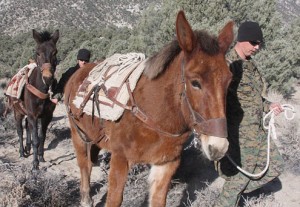Marines, Animals and Counterinsurgency
BY Herschel SmithIn More on Battle Space Weight we covered the almost frantic search for pounds as the fact became increasingly clear that the weight Soldiers and Marines carried in Iraq was heavy, but perhaps even prohibitive in Afghanistan. Exhaustion, lower extremity injuries and lack of mobility mark the heavy weight our warriors carry today. One possible remedy is the Big Dog, the otherwise cool machine that sounds like a million angry bees. Here it is one more time.
To our observation that the warrior today carries at least 32 more pounds than in WWII due exclusively to body armor, commenter mwc33 responded:
Isn’t the other big difference between World War II and today the load our enemies are carrying? German and Japanese troops carried comparable combat loads; insurgents in Iraq or Afghanistan don’t – and the disparity in mobility in Iraq’s urban environment has to be multiplied in mountainous and other difficult terrain.
Those 32 pounds of body armor are a big pain in the a$$ and everything possible should be done to lighten them. But while “big dog” may be kinda dumb, even with the lightest possible armor we’re still carrying 40 -70 more pounds than the bad guys; something has to be figured out to lighten the load – not just because of the weight itself, but because our combat loads can straitjacket us with TTPs and can make us predictable in the eyes of the enemy.
Outstanding point! It’s not just that we’re carrying heavier loads, it’s also that the insurgent isn’t carrying any at all due to the fact that he lives among the population. So even if the Big Dog works, what to do?
The taxpayer has spent billions to make sure America’s fighting forces have the most high-tech modes of transportation.
But in a country like Afghanistan where the enemy hides in mountain lairs, where there are few foot paths, and no roads at all, sometimes a more primitive conveyance makes more sense.
And so soldiers and Marines possibly headed to Afghanistan were at the Animal Packers Course at the Hawthorne (Calif.) Army Ammunition Depot learning how to use mules, donkeys and horses to pack water, ammunition, weapons and medical supplies.
“With vehicles, you have to worry about things like lubrication, tires and fuel,” said Marine Staff. Sgt. Tyler McDaniel. “With animals, you have to think about stuff like shoes and grooming.”
True enough, there may be a call for Farriers in the Marines. Wonder if that will become a billet? At any rate, having trained them before, I am partial to quarter horses, and while on their back I have put them in some precarious and dangerous places and positions on the trail. They are sure-footed and reliable.
But whether horses or mules, the solution may be a millennium old. Well now. It looks as if all of that discussion about the health of transport animals in the Small Wars Manual isn’t so dated and irrelevant after all.






Trackbacks & Pingbacks
Comments
RSS feed for comments on this post. TrackBack URL
Leave a comment